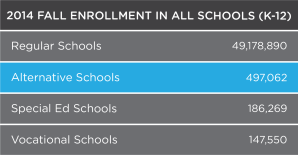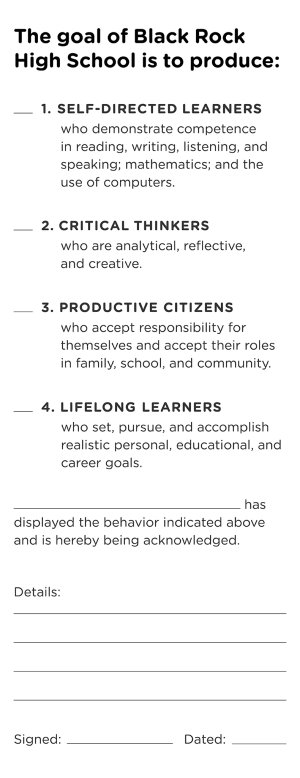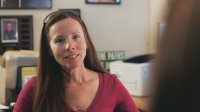Principal of a School on the Edge
The principal of an alternative school opens up about the challenges and rewards of shepherding at-risk kids to graduation.
Your content has been saved!
Go to My Saved Content.Vonda Viland is a mother figure, coach, cheerleader, and counselor. She has to be.
As the principal of Black Rock Continuation High School on the edge of California’s Mojave Desert, Ms. V—as she’s known to her 121 at-risk students—has heard countless stories of personal or familial alcohol or drug addiction, chronic truancy, and physical and sexual abuse. Over 90 percent of the school’s students live below the poverty line; most have a history of serious disciplinary issues and have fallen too far behind at traditional schools to catch up. As a new documentary about the school explains, Black Rock is the students’ “last chance.” The film, The Bad Kids, was awarded the Special Jury Award for Vérité Filmmaking at the Sundance Film Festival in 2016.
Viland, who often arrives at school and flips the sign on her office door to “The witch is in” at around 4:30 a.m., isn’t the type to shrink from a challenge. The film tracks the progress of several students over the course of a turbulent school year, capturing Viland’s tenacity and the dedication of the staff who work alongside her. Is she ever discouraged? “Not ever,” she told Edutopia, before refocusing the conversation on her simple guiding philosophy: Stay positive, take it one day at a time, and focus relentlessly on the child in front of you. At Black Rock, despite the long odds, this appears to be working: Last year, 55 students who hadn’t succeeded at traditional high schools graduated, with 43 enrolling in community college and 12 joining the military.
We interviewed Viland as the national premiere of The Bad Kids on PBS’s Independent Lens series approached. (Airs tonight, March 20, at 10 p.m. ET—check local listings.)

Edutopia: The film is called The Bad Kids, but they’re obviously not really bad—they’ve faced a lot of adversity and are struggling to finish school. Can you generalize about what brought them to your school?
Vonda Viland: Absolutely. In the community, you’ll sometimes hear that this is the school for the bad kids, because they’re the kids who were not successful at the traditional high school. When they come to us, they’re too far behind in credits, they’ve missed too many days, they’ve had too many discipline issues. So it kind of became a joke that it was the “bad kids,” and the filmmakers struggled with the name. But our kids are actually amazing individuals—they’re so resilient, they have such grit, they have big hearts because they know what it’s like to be on the bottom. The filmmakers finally decided that they were going to go for it and name it The Bad Kids. Obviously the professional term is students who are at risk, or students who face trauma in their daily lives. But we just thought, “Let’s just embrace it and own it.”
Edutopia: Can you talk a little bit about the different experiences and backgrounds your students have?
Viland: Some of the students who attend here are homeless. They come from families where there’s been drug addiction, alcoholism, physical or verbal abuse. They suffer from generational poverty. Often, no one in their family ever graduated from high school, so education has not been a priority in their families. Many of them are the caregivers for their siblings.
Edutopia: A lot of people walk away from these kids—their parents, their siblings, other schools. What draws you to these students?
Viland: Honestly, if you take the time to talk with them and to listen to them, they will open up and tell you everything you want to know. They fill my cup much more than I can ever, ever fill theirs, and so they’ve just inspired me so much that I can’t imagine working with any other population. This demographic has always been the group of kids that I’ve navigated to.
Edutopia: Are you ever discouraged, seeing the challenges and the odds the students face?
Viland: I’m not ever discouraged with the students. They bring me great hope. I really believe that they are a huge untapped resource of our nation because they are so resilient, they are so determined. I do sometimes get discouraged with society. I can’t get resources for the students because of where we live. I don’t have a counselor. I don’t have any outside resources to tap into. Our nearest homeless shelter is 90 miles away. So that’s where my frustration and my discouragement comes from.
Nobody wants to be a failure. Nobody wants to be the bad kid. Nobody wants to screw somebody else’s day up. They’re doing that because they don’t have the tools to not do that.
Edutopia: How do you feel if a student doesn’t make it through, doesn’t graduate?
Viland: It breaks my heart. But I am a firm believer that our job here is to plant seeds. I have seen it happen over and over again in my 15 years at the continuation school: A student leaves us, and we feel like we didn’t reach them or we didn’t make a difference. But we planted enough seeds that they eventually grow. Later on the students come back, and they let us know that they went back to school and graduated, or they’re trying to get into the adult high school and ask for my help.
I get emails all the time like “Hey Ms. V, I just wanted to let you know I’m now a school administrator,” or “Hey Ms. V, I made it into a four-year college, and I just wanted to let you know that it’s because of Black Rock.” That is our source of inspiration.
Edutopia: That leads right into my next question, which is that you seem to spend a lot of time with individual students. Why is that important?
Viland: I really believe that you can’t teach curriculum if you don’t teach the child. I usually come into school by 4:30 or 5 every morning to do all the paperwork, so that I can spend the entire day with the students. I find that if I make myself available, they come and utilize me when they’re having a good day, a bad day, or they need advice on something.
I am a huge proponent of the power of positive. We run this program completely on that—it’s all counseling and the power of positive encouragement. I hold up the mirror and say, “Look at all these wonderful things that you are doing, and that you can control.” I think that helps give them a little more resiliency, a little more self-esteem and faith in themselves to move forward.
Edutopia: Are there kids who come into your office a lot?
Viland: Well, you take a student like Joey [who is featured in the film], who’s suffering from drug addiction, and he and I spent hours upon hours together. We read the book Adult Children of Alcoholics together. We spent hours talking through his demons. So it really depends on the student and what is necessary for them. A lot of students who suffer from anxiety, I spend maybe 20 minutes a day with each one of them. Maybe one day it’s going to take an hour if they’re hyperventilating and can’t move forward with life. I never schedule my day.

Edutopia: How is Black Rock different from a traditional school?
Viland: At a traditional high school, you’re stuck there from September to January and January to June for the typical quarter or semester program. At our school, the students can graduate whenever they finish. So there’s a lot of motivation to work through the curriculum quickly and, because they can’t receive anything under a C on an assignment, to produce quality work. If our students want to be done and move on with their lives, they’ve got to do the work. So far this year, I’ve had 21 graduates. The day they finish that last assignment, they’re done.
And on their last day here, they walk the hall—everyone comes out and says goodbye to them. It gives the students the accolades that they deserve for their hard work and growth, but it also inspires other students. When they see somebody who had a bad attitude or was a discipline problem, when they see a student like that walk the hall, they say, “If they can do it, I can do it.”
Edutopia: What would you say to principals and teachers at more traditional schools who are trying to reach the so-called bad kids, the at-risk students?
Viland: The first step is always listen to them. Find out the whys: “Why weren’t you here yesterday? I cared that you weren’t here yesterday.” Or: “Why is it that you’re not doing this work? Is it too difficult for you? Are you feeling hopeless? Are you feeling like you’re too far behind? Has somebody told you you can’t do it?” Make that connection on a personal level and let them know you care, and then listen to what they have to say, because most times—nine times out of 10—they’ll tell you what the issue is if you just take the time to listen.
Edutopia: How do you think your students view you?
Viland: As a mother—they call me Mom. They also kind of joke and call me Ninja because I have a tendency to just appear out of nowhere. I’m always around. I think they see me as a safety net. I’m not going to judge them. If they lose their temper and go off, I tell them, “Look, I’m not going to punish you. I’m here to teach you.” Punishments only punish. They never, ever teach.
Nobody wants to be a failure. Nobody wants to be the bad kid. Nobody wants to screw somebody else’s day up. They’re doing that because they don’t have the tools to not do that. That’s our job, to give them the tools that they need to reach their potential.
